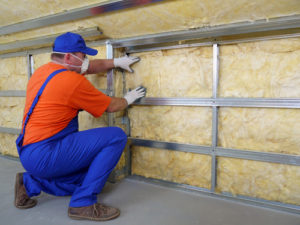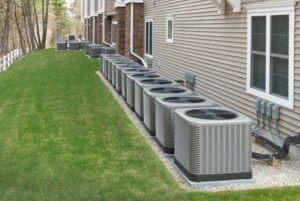Pay Attention to Sealing and Insulation in Your Illinois Home for Year-Round Efficiency
 No matter how efficient the heating and cooling systems are in your Highland Park home, if the outer envelope of the building isn’t sealed and insulated properly, your utility bills will be much higher than they need to be. With the following tips, you can learn to identify the areas where your home’s sealing and insulation may be sub-par and learn the steps you can take to improve the situation in order to keep your home energy efficient and comfortable all year long:
No matter how efficient the heating and cooling systems are in your Highland Park home, if the outer envelope of the building isn’t sealed and insulated properly, your utility bills will be much higher than they need to be. With the following tips, you can learn to identify the areas where your home’s sealing and insulation may be sub-par and learn the steps you can take to improve the situation in order to keep your home energy efficient and comfortable all year long:
Finding Areas With Sealing and Insulation Problems
For the best identification of problem areas, you may want to consider having a full energy evaluation done, which uses methods such as the blower door test and infrared cameras to locate areas that have air leaks or poor insulation, even if they’re hidden from view. On your own, however, you can spot most of the problem areas using the following steps:
- From the outside of your home, inspect the foundation for cracks that could allow air to escape, and check for any missing or broken siding and trim pieces.
- Examine the perimeter of door and window openings for visible gaps where the frames meet the siding, and if storm windows are present, make sure they’re seated properly against the window frames.
- Check the exterior of the home for plumbing, gas and electrical lines that run through the exterior walls, and make sure there are no gaps around the lines.
- Locate any dryer or exhaust fan vents and make sure they open and close properly, and that they’re properly sealed where they meet the siding.
- From the ground, check the roof for any obvious signs of damage, such as warped, missing or broken shingles.
- From the inside of the home on a windy day, use a stick of incense or something similar to detect drafts around windows, doors, exhaust vents, electrical boxes, and any cracks in the walls or ceilings for drafts.
- In the basement and attic, check the areas around plumbing lines, waste vents, electric lines, chimneys and flues for gaps where they go through the wood frame of the house.
- Where it is accessible, inspect the insulation for signs of damage, such as mold, and note any areas where insulation is missing.
- Check underneath dirty insulation for signs of air leaks, which will deposit dust into the insulation as the air moves through it.
- Measure the amount of insulation present.
Sealing and Insulation Improvements You Can Do Yourself
While jobs like repairing the siding and roof are best left to professionals, some of the sealing and insulation improvements can be done yourself with the following tips, if you are somewhat handy and would like to save some money:
- Install foam, rubber or cork weatherstripping around the operable portions of doors and windows, where compressing the material will create a tight seal.
- Apply caulk or use rope-type weatherstripping around the fixed portions of doors and windows to seal any other gaps, including where the frames meet the siding.
- Use the appropriate caulk for the material to seal cracks in the foundation and siding, gaps around plumbing, gas and electrical lines, exhaust fans, vents and electrical fixtures on the outside of the home.
- For gaps larger than half an inch, use a combination of expanding foam insulation and caulk to create a proper seal.
- Use caulk to seal around any plumbing or electrical lines that pass through the framing in the attic and basement.
- Use flashing and high-temperature caulk to create an airspace around chimneys and flues to prevent contact with insulation, and use either flashing or screen to do the same for recessed lighting that’s not rated for contact with insulation.
- Install insulation baffles in the eaves of the attic before adding insulation to ensure proper roof ventilation.
- If the attic floor has 3 to 4 inches of insulation already, replace any damaged insulation and add up to R-49 to the existing insulation, using alternating perpendicular layers.
- If there’s no insulation in the attic at all, add a minimum of R-49, up to a maximum of R-60.
- For the basement floors, use R-25 to R-30, and go with R-19 for the walls. If the siding is replaced, add foam beneath it to increase the wall’s insulation.
To learn more about how proper sealing and insulation can help your HVAC system perform more efficiently, contact the experts at Carefree Comfort, Inc. Heating & Air. We serve Highland Park and surrounding areas.
Image Provided by Shutterstock.com
You May Also Like

Should My Heat Pump Sound So Noisy in Lake Bluff, IL?
Heat pumps should work not only efficiently but quietly. If any strange sounds begin disturbing the peace of your home, we strongly… Continue Reading Should My Heat Pump Sound So Noisy in Lake Bluff, IL?…

How UV Lights Work to Improve the Air Quality of Deerfield Homes
In the quest for a healthier home environment, many homeowners are turning to a powerful ally – UV-C light. Ultraviolet (UV) light,… Continue Reading How UV Lights Work to Improve the Air Quality of Deerfield Homes…

Should My Furnace in Lincolnshire, IL, Sound So Loud?
Malfunctioning furnaces behave strangely while regulating indoor temperatures. One of the odd things a faulty furnace does is produce loud sounds. Let’s… Continue Reading Should My Furnace in Lincolnshire, IL, Sound So Loud?…
